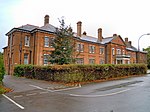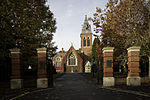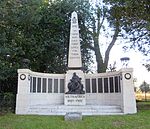Aldershot Observatory
Astronomical observatories in EnglandBuildings and structures in AldershotGrade II listed buildings in HampshireMilitary in AldershotUse British English from October 2010

Aldershot observatory is a circular red-brick building with a domed roof standing on Queens Avenue in Aldershot Military Town near Aldershot, England, home to the British Army since circa 1854. Inside is an 8-inch (203 mm) refracting telescope on a German-type equatorial mount with a clockwork drive which will run for about 2 hours without rewinding, this has a facility to vary the drive rate. The telescope and observatory building were a gift from aviation pioneer Patrick Young Alexander to the British Army, a fact which is recorded by a plaque near the observatory door. It reads: ‘Presented to the Aldershot Army Corps by Patrick Y Alexander Esq 1906’.
Excerpt from the Wikipedia article Aldershot Observatory (License: CC BY-SA 3.0, Authors, Images).Aldershot Observatory
Queen's Avenue, Rushmoor
Geographical coordinates (GPS) Address Nearby Places Show on map
Geographical coordinates (GPS)
| Latitude | Longitude |
|---|---|
| N 51.258412 ° | E -0.762339 ° |
Address
The Cambridge Primary School
Queen's Avenue
GU11 4AA Rushmoor
England, United Kingdom
Open on Google Maps








